a bit rough for now
but we are slowly getting it better...check out our new location: www.opaz.net
brain farts...flotsam...driftwood...and meanderings on hedonistic endevours
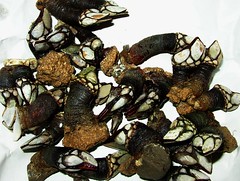
percebes
Originally uploaded by obiscoito.
So ever had a goose neck barnacle? They are very hard to harvest and infact come with a piece of the rock that they were attched to. To cook, boil for 5 minutes or so in lightly salted water. Then hot or cold you snap off the pointy part and pull out a small thin piece of meat. The flavor is of salt air with a light sweetness and tender flesh. They take awhile to eat and squirt juice all over as you snap them apart. But boy are they good! Oh not to mention expensive, and to think you're paying for the rock too!
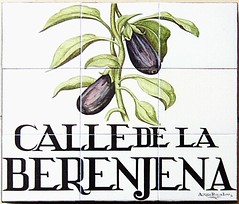
calleberejana
Originally uploaded by obiscoito.
I love eggplant. And I really like streets named after them. This street is about a half a block long and I don't think there is one address on it. Pitty really, how great to be able to say I live on the Egglant Street!
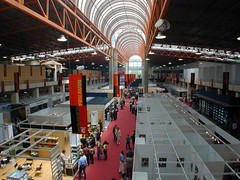
Fenavin Expositores 2001 a
Originally uploaded by obiscoito.
The main hall at the FENAVIN exhibition. Quite big as you can see and lots and lots of wine to taste.
So yesterday I spent all day at FENAVIN the biggest trade show in Spain for all wine from all regions. Bigger than anything I've ever seen before and the chance to try what was to be over 1000 wines. With spitting as a strict rule I was able to make a small dent with about 70 wines passing my lips. I'll tell more soon but for now a few of my notes on some of the fun Sherries I was able to try. Enjoy, Till soon, Ryan
Posted from CellarTracker!
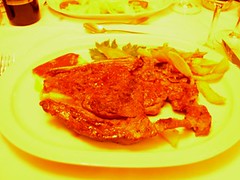
SteakAvila
Originally uploaded by obiscoito.
A special black cow is raised in this DO. Avila produces a lot of meat and this was one of the finset steaks I´ve ever had. Basically a bone on ribeye! MMMMMMMMM......
...(this is a story from my trip to La Rioja, I just finished editing it!) enjoy...
Having to this point in my trip conserved my pennies; I decided that at least one night I was going to treat myself to decent meal at a nice restaurant. Every time I am traveling in Spain, I always take along my favorite travel guides, and they both agreed that when eating out in Haro the best bet was Asador Terete. An Asador is in someways the equivalent to a steak house in America but without the steak or potatoes. The Asadors all have wood fire ovens and specialize in the technique of slow roasting meats to create mouthwatering meals. My goal tonight was to try a local specialty of La Rioja, Cordero Asado; roasted suckling lamb.
Yes the same suckling sensation that I had tried in Segovia only this time with a small helpless lamb. Thank you mister lamb for your sacrifice and now back the story...
So, heading out at a reasonable 9pm, the restaurant located in the upper portion of the building did not have its lights on. Thinking that I at least wanted them to be prepared for dinner, I decided to do a quick walk around the city and then headed back. Still no lights. I started to think maybe tonight was not to be and that I might have to frequent one of the many other asador’s located throughout the heart of Haro. Though I wasn’t going to leave without at least asking and upon entering the first floor bar I was greeted by a man watching TV. Asking if I might eat something tonight, I received an enthusiastic, “Si, Si!” while he called up the stairs for someone to turn the lights on. What service! A whole restaurant opened on account of my hunger! Later on in the evening, I was to learn that it might have been better if they had shut the door then and there.
Walking into the room I was greeted by a young man in a nice sweater who made it clear I could sit where I pleased. Looking around, I saw that each wall was lined with butcher block style picnic tables and on each side sat a long narrow bench. So comfort was not what they were going for, hoping that money saved in interior design was put to a more important cause; like food.
After being seated, my server draped a checkered picnic blanket across my table and arranged a complete place setting on top. So far so good and as I scanned the menu I realized that I must make sure to order wisely or else I might just accidentally provide the funds for any future remolding. Quickly found the Cordero Asado and was not pleased to see it in a league of it’s own as far as price goes. Oh well, this one item coupled with wise choices elsewhere would not hurt the wallet too much and so I ordered: soup, lamb, wine, and dessert a simple menu and yet one fit for a king.
At this point, my solitary state was about to be interrupted. Bursting up the stairs came three individuals all tipping their heads to me with a “Hola, Buenos Noches” as is customary when you walk into the room. Replying, I acknowledged them and continued to wait further for my meal to makes its way to the table. Immediately, I knew I had a problem though with these new arrivals. Looking over towards the new arrivals cautiously, I noticed that the “henchman” or “money” for the dinner was a unique man of rather large stature. In and of itself, not a problem, but his voice which was loud and gruff was accompanied by a rather loud breathing problem. Somewhat I assume like an asthmatic buffalo grazing on the plains. Huff, wheeze, snort, huff…wheeeeeeze! Non-stop, and to say the very least incredibly irritating! This was also accompanied by random loud outbursts followed by loud sounds as the buffalo slapped at the portion of his female companion’s rear hanging over the inadequately off narrow bench. Without any music in the background, I resigned myself to the fact that for tonight this would be my ambiance!
By this point in the evening, I had been given a small plate of bread and wine; and while attempting to enjoy these I did my best to ignore my new companions who also chose one of the closer tables to me. But the calm was now over as the buffalo started to talk at a level that indicated he was hoping for my attention. Reluctantly looking over, I noticed him waving and between labored breaths, it appeared that he was trying to communicate something to me in his Span-uffalo language. Getting up, he approached my table, the whole time snorting while his voice grew louder.
I remember being told once that if a moose or for that matter a large buffalo charges you that you should remain calm and do not try to outrun it. Whether this is true or not I don’t know but I thought I would try out the theory! With fear guiding me, I tried my level headed best not to move or say anything. Pointing to my bread in a Clan of the Cave Bears sort of way, I realized that all this beast needed was some nourishment for his already enormous belly. Holding out the bread he feigned politeness and mentioned that only a little would be necessary until the feeding trough was properly situated in front of his table. So to end this encounter as quickly as possible, I quickly split the loaf and handed half to him where with muffled breathing and sounds of moist mastication he loped back to his table. Fortunately, I was able to limit this encounter to a one time event.
Soon after this small storm, I was brought a large serving bowl of soup accompanied by a bowl and ladle. Nice self service. I quickly dug in hoping to kill the most severe part of my hunger so that it didn’t interfere with the main course. The soup consisted of a light broth with small noodles that wouldn’t have surprised me if it had come out of a small bag marked CHICKEN FLAVOR across the front. I can’t in fairness complain as this was the cheapest appetizer on the menu and not one recommend by the waiter. I had hoped to have a vegetable stew that is native to the region but it was also priced a bit closer to the main course than I would have liked. Oh well, tasty and at least I wouldn’t have to worry about this course interfering with my enjoyment of what was to come.
As I was finishing up, the restaurant received the last set of guests for the evening, a party of four and fortunately, all polite and quiet. So with buffalo and party providing the ambience for the evening, I was ready to move on to the second course.
Simplicity is of the utmost importance in the preparation of certain items in Spain. Roasted lamb is one of these things, and at times, I long for the sprig of parsley that most patrons throw to the side if only to liven up the plate a bit. Before me sat a square white plate with a roasted leg, skin glistening with small rivulets of fat as they cascaded down into a pool of pale yellow water. Nothing more. At first I was a big disappointed by this, no flair, no plates slamming down to cut the leg from the rest of the animal, no flames, or dancing, just bones, meat and juices. Let me explain the process of cooking a lamb a bit as I have heard it told by others.
First, take a lamb still sucking from the teat and kill it then remove all wool and organs. Second, sprinkle with salt water and set in a ceramic crock. Third, sunburn said animal at high temperature in a wood fired oven. Fourth, slowly cook it to perfection at a slightly lower temperature till done. Finally, serve on a plate making sure to sprinkle the juices over the top and adorn with a salt shaker.
(gab start here)
Sound good? Well it is, once you get into it. Granted, I had come hoping to be amazed and at first, I was not. What I did feel, though, was that this was a very interesting and quite tasty dish, though nothing to write home about. On the other hand, I am now writing home about it and for good reason. As you delved deeper into the heart of the shank the meat became more sweet, tender and moist. I lingered at first trying to decide whether or not I liked it and found that as I went deeper into the flesh I was incapable of governing the rate of my consumption. Gentle pieces of sweet flesh melted in my mouth coating it with a decadent layer of milk fed fat, surrounded by crisp delicate skin creating a contrast that my mouth delighted in. To accompany this was a Crianza from La Rioja, a wine made by the same people who owned the restaurant. I wondered if the wine was made with the lamb somewhere in the back of the winemaker’s mind.
Terete, Reserva Especial 1999, Rioja, Haro
Deep purple w/only the slightest browning at the edge. Sour cherry nose with light black pepper. Med body with little in the way of tannins, and a nice acidity. Flavors of dried cherry, light leather, and dried fruit. This wine developed nicely over 2 hours and might still have continued to evolve if I had let it. 8euros
The dried fruit, leather and light black pepper all merged flawlessly with the delicate meat never overpowering the lambs delicate myriad flavors, rather the wine only helped to balance out the richness of the meat with a light spice and lush acidity.
Wheeze, snort, Hurmph, and what I hoped was not a “toot!!” erupted from the next table over, and I was quickly reminded of another reason not to linger too long on this treat. Was this dinner all that I hoped it would be? No, but it did show the potential and give me the desire to seek Cordero Asado out again. Maybe I will go with a group sometime so that the whole lamb could be shared and passed around, allowing everyone to experience the different cuts of meat. One such cut of meat I did decide to pass on this time was the lambs head. In the front display window of the restaurant, there was a peculiar platter set out for all to view. At first glance, I could tell it was meat, though of what part of the animal I was not sure. Upon further inspection, I realized that there were four lambs heads, split lengthwise arranged on a platter in a small circl,e curious I wondered if they were for show or for dining upon. When I looked at the menu later in the evening, I discovered that it was indeed for eating, and although I was not ready for this experience, I made sure to take note of it, while wondering in the back of mind how it might be prepared. Fortunately the second set of restaurant patrons answered this question for me. Looking up I saw presented to one of them both halves of the head with everything inside apparently roasted in the same way my meal was and with as much simplicity. Unfortunately I think that it may take more than a sprig of parsley to make this dish palatable for me, not so much for the taste or texture but rather the appearance!
At this point I was becoming surprisingly full, and I declined all but a small plate of strawberries and cream for an after dinner treat. Slowly enjoying the crisp light flavors of the berries after the richness of the lamb, I felt happy that I had been able to experience suckling lamb. Barring my company, the night had turned out to be a valuable experience and my only regret was not having had someone to share it with.
Leaving the restaurant I said goodbye to the same man still watching the TV and headed out in search of a café to help with my digestion. You see at the end of the meal I went to order a coffee and was told that they did not serve it! Confused I pondered the fact that coffee to this point had been served everywhere I went. It seemed sacrilegious not to have it. Why should a place where I can access the internet have coffee but a restaurant where I have a nice meal not? Oh well, Sipping my coffee I thought of all that I had seen today and tasted and I started to feel better. Not to mention at least the coffee was not interrupted by the occasional snort!
Till soon, Ryan
So, I feel a bit under prepared for this task. Last week, I had an experience that all wine connoisseurs should have at one point in their life. Put simply, I went to a wine museum. What is not so simple is that it claims to be one of the largest and most extensive tributes to wine in the world. Nestled at the foot of the Sierra de Cantabria Mountains is a small town named Briones. Located in Rioja Alta about 5 kilometers from Haro, Briones is smack dab in the in the epicenter of the majority of La Rioja vineyards. Scenic, beautiful and small, the town was probably no more than a cathedral on a hill to tourists before the museum was built. Consequently, I was a bit surprised when I was told that you needed a reservation to visit. Though this seemed a bit ridiculous, considering the location, the representative at the Tourism office booked me a one person tour for 3pm that afternoon.
When I arrived, I was greeted by a nice gentleman who spoke very good English and flashed a smile that made you feel welcome. I explained my story of coming here from the US, leaving a wine shop, and now, embarking on a journey to write some articles, and hopefully, work in the wine industry. Hearing this, a man from behind him popped up and asked if I was with the Press. I explained that I hoped to write a series of articles for an online publication. For this, I was rewarded with free admission and a document to sign stating that I would be a "good" journalist! Basically saying that I would not be malicious and requesting an address to send any info about special events.
Before I began the tour, they explained the layout and what to expect from the museum. Yeah, yeah, yeah, I've been to museums before, and was expecting from the looks of it a fancy rehash of wine display’s that I had seen before. After taking my ticket and stowing my bag (no cameras), I walked up to the entrance; my first indication that this was not to be any ordinary wine experience.
I waved my ticket under a laser scanner and was let into a room empty save a few short benches. As I moved forward, the lights began to dim and I was greeted in English by the owner of Dinastía Vivanco who gave a short 15 min presentation about their vineyards and the reasons behind building the museum. Leading you through the vineyards and surrounding areas with some of the most amazing scenic footage of Rioja, the film helped to focus your attention away from the world outside and started you thinking solely about wine. So far, so good! At least I wouldn’t be too bored.
Finishing the film, the lights came up and I walked out into the first gallery of 5 total. With dramatic lighting and sounds of the land all around me, I was led by arrows through an impressive display of the first origins of wine. Ancient serving vessels, tools for harvesting, wine presses, a multitude of vineyard management tools and much, much more. This was not a boring "Oh look at the old thing there" tour, but one created to educate you by showing and explaining every detail of wine making from the far past to present day.
About half way through the first gallery, I came across 3 large movie screens, with a synchronized video showing the life of the vine from winter through fall. Set to ambient sounds of the vineyard, you are transported out of the museum and into the vineyard finding yourself lost in the vine’s life cycle.
As you finish the film you are snapped back into reality, and you continue on to learn what needs to happen to make this vine’s grapes give you wine. With the dim lighting and focus on detail you rarely find yourself without things to look at including towards the end of the first gallery an audiovisual display of the process of fermentation from a grape’s perspective! Complete with sounds. You can almost smell the must ferment, and part of me wonders if they might be pumping in smells to help make the experience more real.
Agog, and not needing to be impressed further, I still had 4 galleries to explore. Descending a ramp that wound like a vine throughout the entire building, you begin to hear sounds of chainsaws and hammering. Rounding the corner, three videos are explaining how the essential tools to craft wine are formed. Examples of barrel making from tree to barrel, bottle making from sand to bottle and cork making from tree to cork all are captured on video for you to watch. Each video so thought out and detailed that I found myself getting lost in each one unsure of where I was. What makes this place special is that the questions no one ever thought to ask are answered here. While I have studied the process of barrel, bottle and cork making in the past, to actually see the processes helped to make it more real for me. In all of the films, the most captivating aspect was the lack of voices or commentary. Watching the barrel formed from a log to a barrel without voices sucked me in, whereas a loud voice explaining the next step might only confuse me and break the magic. Though there were plenty of texts in English and Spanish to explain everything you looked at, there were no vocal explanations. In this way, they made the experience more visceral allowing the wine to speak in its own voice, a universal one.
In awe, I slowly wandered out of this gallery. Winding further down into the 3rd gallery I was greeted by ancient stone and wood grape presses, some bigger than a semi-trailer towering over whoever passed them. The presses were surrounded by more displays of wine - my favorite being the interactive ones in the back right corner, which meticulously explained the parts of wine that you can only experience from tasting. A daunting task for any normal museum but taken in stride here at Vivanco. In a state of the art display looking more like a space station cafeteria, sat a wall of bright images above a series of small domes. To the side of the domes were small strips of paper. The goal of the display was to have you push a small button in front of the dome causing the lid to rise, and with your paper strip, rub it across a small wick that sat inside. Putting the strip under your nose, you could actually smell the aroma displayed in the picture above the dome. There were 28 different aromas, from anise to petrol to honey, and for the most part, all were very accurate interpretations of there respective flavors. A big touch screen followed the scent domes where you could play games to test your wine knowledge. For instance, can you accurately place common smells with specific wines? Part of me thought I had been transported to a children’s museum for adults.
With so much to see and look at I was already becoming fatigued from walking and reading. I found myself skipping over some of the displays in hopes that I might return someday to re-examine them. If I had one complaint, so far, it would be that I was not warned at the immensity of this display. Had I known, I might have scheduled 2 trips.
Gallery 4 was the only traditional gallery that I experienced. Inside was a mausoleum to all the ways wine has been depicted in art throughout the ages. From Egyptian hieroglyphics, to Picasso this was the Prado in miniature and with a very specific scope of interest. On top of paintings, sculptures and mosaics in one corner there is a small room with a video showing how wine had been depicted in cinema. I have to say I was becoming to realize that this was more than a wine museum. This was a monument to wine and a gift to those who love it.
With my mind about to explode from over stimulation it was nice to have a short respite in the form of the Dinastía Vivanco Crianza barrel aging room. Cool, calm, dimly lit and with the rumblings of what sounded like storm troopers in the distance this octagonal shaped room looked more like a set from an epic Hollywood movie than a wine cellar. All the barrels were ordered in neat stacks and because the room was in the shape of an octagon, it gave the impression of infinite space.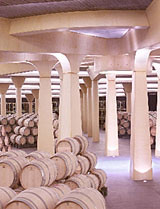
Standing and looking around this room, I stopped and let my mind wander a bit before the final assent to the last gallery.
Enter the corkscrew! Ever look at a corkscrew and find it interesting, maybe thinking to yourself that at some point you might want to start a collection. I mean, really, how many different types of corkscrews could there be? Well, the last gallery answered the question with a resounding 2000 give or take a few. As if the number wasn’t astounding enough, they were grouped according to theme, epoch and design. Having only been in use for around 300 years, there have sure been a lot of modifications to this simple object. For example, they have been fashioned into everything from walking canes with them hidden inside to pornographic corkscrews where the god Pan has a screw where anatomically he shouldn't all arranged on tall walls that made viewing easy and surrounding a center space that held a somewhat smaller tribute to decanters.
With my head swimming in wine, I stumbled toward the exit where, once again, where I needed to wave my ticket under a scanner to release me from the confines of the galleries.
Walking out, I was led to a bar to try the Dinastía Vivanco Crianza. In order to celebrate a nice end to a long journey, the wine was well appreciated and helped me unwind.
In my life, I have learned a lot about wine and know that I have much, much more to learn before it is over. But I consistently run into displays about wine and its culture that bore me with the details of fermentation or "how to taste". Vivanco did not. It actually helped me feel alive and excited watching and learning how a wine is made from grape to bottle. Magical, academic, and reverent, Dinastía Vivanco has something to offer everyone. No matter how much or how little you know, ANYONE who loves wine will learn or see something that they did not know before. I only hope that everyone with any interest no matter how remote in wine has the chance to one day pay homage to this tribute.
For people in the wine trade, there is also a large library of texts for research and a small cafeteria accompanied by a high end restaurant featuring wines of the region.
As I left, it was raining and I wasn't able to wander the grounds outside, but I did leave with great memories and a desire to return. This will stand as one of my top ten wine experiences renewing my desire to make wine a permanent part of my life.
Thank you Dinastía Vivanco